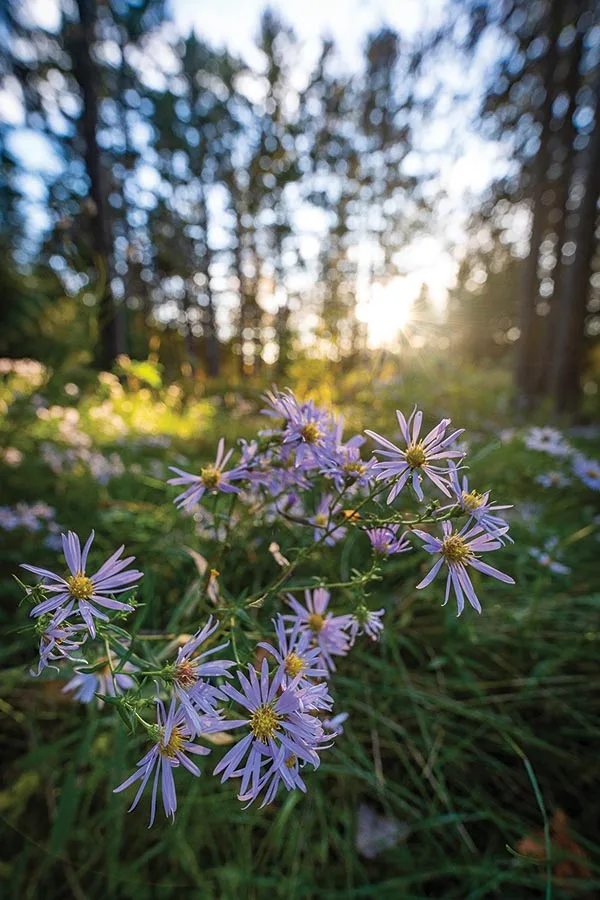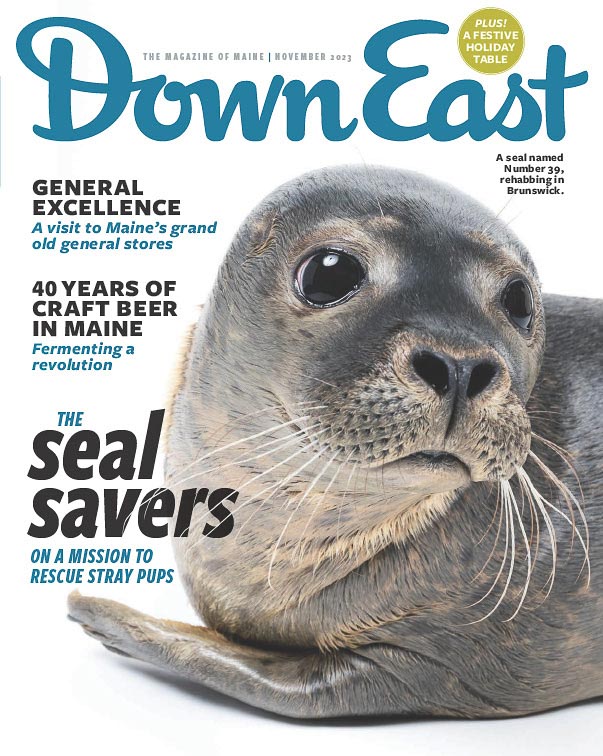By Brian Kevin
Photos by Chris Shane
From our June 2023 Island Issue
As far as I know, the island I’m choosing to call Lyons Island does not, in fact, have a name. Among the people who, most recently, had some standing to give it one are those buried in a small cemetery on the mainland nearby, who have lent their surname to Lyons Road, a ribbon of gravel that winds up Huckins Neck, in the northwest corner of Lubec. The neck is the middle tine of a lopsided trident that juts into Straight Bay, an inner Cobscook Bay estuary. One morning last fall, I parked my car at the tip of it and followed a short trail to what the property’s current owners call Lyons Point. It was just after dawn, and as gulls cackled over the rumble of a distant engine, I peered out at a foggy panorama of spruce-topped islets scattered across the bay. Then, I slid on my gaiters, squelched across 100 feet of grassy mudflat, and clambered onto one of them.
Lyons Island is what Maine’s Coastal Island Registry refers to as a barred island — otherwise known as a tidal island or a “sometimes island,” linked to the mainland when the tide is out and surrounded by water when it’s in. The state registry notes 23 such islands among its 3,250 entries, although that list is not exhaustive. Among Maine’s best-known is Bar Island, off MDI, which is linked to Bar Harbor at low tide by an eponymous sandbar — and upon which hapless hikers lousy at timekeeping occasionally find themselves stranded.
Tidal islands aren’t rare, per se, but they’re largely limited to pockets of the globe with big tidal ranges and morphologically complex shorelines: that Maine is rich with islands one can sometimes walk to puts it in fairly exclusive company. Across the pond, Great Britain claims 43 of them, some of which draw tourists for their breathtaking castles, abbeys, and monasteries. Around the world, tidal islands often host sites of religious pilgrimage, like Mumbai’s Haji Ali Dargah or the Shrine of St. Thérèse, in Juneau, Alaska. The U.K.’s most famous tidal island, Lindisfarne, was the cradle of Celtic Christianity in the 6th century, the monks drawn to its balance of accessibility and “otherworldly spiritual refinement,” as one scholar writes, its sense of being “mutable and ambiguous, sometimes linked to the mainland and sometimes isolated, negotiating a hybrid identity of connection and retreat.”
I’m no monk, but I’ve been known to negotiate my own little hybrid identity of connection and retreat. Which is why, feeling retreat-y last October, I asked the folks from the Lubec foundation Cobscook Shores for permission to spend half a tidal cycle hanging out on little Lyons Island — walking on at low tide, watching it transform into an island, then walking off again 10 or so hours later, after it transformed back. Cobscook Shores manages the island as part of a day-use preserve called Island Coves, the only site in its network of incredible small parks, scattered around Cobscook Bay, that requires prearranged visitation.
The first thing I did on Lyons Island was lay out my sleeping bag on some spongy earth next to a big downed spruce and take a nap. After that, I made some instant coffee and had a look around. It took 140 paces to walk across the island at its widest point. On the side facing the bay, muddy cliffs plunged 10 to 20 feet onto a stretch of rockweed-covered flats (a seaward-facing sign, warning against harvesting it, was the only indicator of human presence). Slick granite ledges ringed the rest of the island, which was otherwise covered none-too-thickly in spruces, firs, and yellow birches, along with one small stand of cedar and a single majestic maple, near the island’s center. Around it, for 10 feet in every direction, the leaf litter was crimson against the rest of the island’s green — an island within an island.

→ IF YOU GO
The parklands of Cobscook Shores are open May through October. The mainland portion of Island Coves, at the end of Lyons Road, has hiking paths, a restroom, and a screened picnic pavilion. Arrange a visit online (and consult a tidal chart before you do).

Around 11:30, I settled with my lunch on a big flat rock facing the mainland, ready for the show. When the tide came in, it came fast. Three bites into my PB&J, I still could have gotten up and walked ashore. By the time I was licking the jam off my fingers, only a cordon of mud linked the island to the mainland, twin curtains of gray water lapping at it from either side, like a zipper slowly closing. By noon, I could have waded across. By 12:10, I could have paddled a kayak. By 12:20, I don’t think I could have touched bottom.
On the back end of the island, the water had swallowed up the mudflats, so the cliffs dropped straight into the bay. With the fog burned off, the water glistened to the horizon, interrupted by a messy geometry of islands, outcrops, and peninsulas. Later, when I asked Charlie Howe, Cobscook Shores parks director, why that particular parcel seemed like park material, he extolled “the views from out there, the intricacy of the shoreline, this landscape that’s a mix of water and rock and that changes totally in the span of six hours.”
With an island to myself and no agenda, I read magazines, skipped stones, admired a bald eagle and some early-arriving eiders through my binoculars, and poked for a bit at a berry-filled pile of racoon poop beneath the maple. The solitude was delicious. The peninsula that Ezra and Philena Lyons homesteaded more than a century ago was later subdivided for residential lots, but few were ever built (the island is easy to explore because its understory was cleared, prepping it for sale as a homesite). In the 2010s, the foundation behind Cobscook Shores cobbled together four lots to form Island Coves, but the deeds prohibit commercial use. That’s why, in order to visit, a would-be island-walker must first email and ask. “Having it invitation-only is so the use is of a frequency typical of residential lots,” Howe later told me. “So it’s part of the magic of Island Coves that you’re out there kind of by yourself.”
That evening, when the tide had receded and I walked off the island, part of the magic was also the astounding slanted light, tinging islands, coves, and sky a perfect golden. I paid my respects at the Lyons family cemetery, near the park entrance, then wandered along the shore, admiring the island from different angles, until the sun had set and I’d had my fill of otherworldly spiritual refinement.


